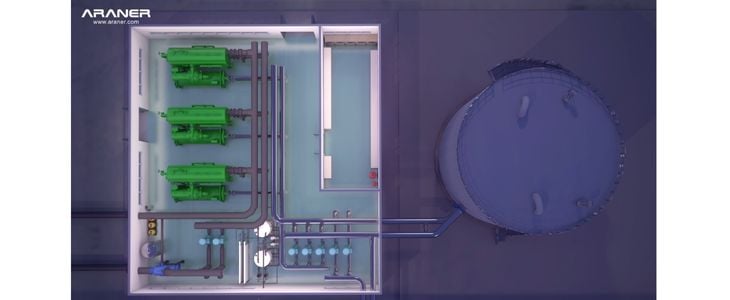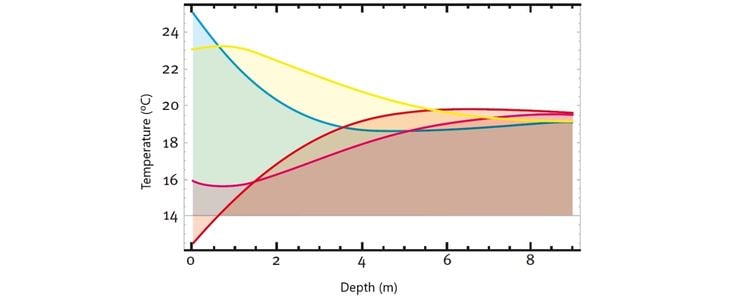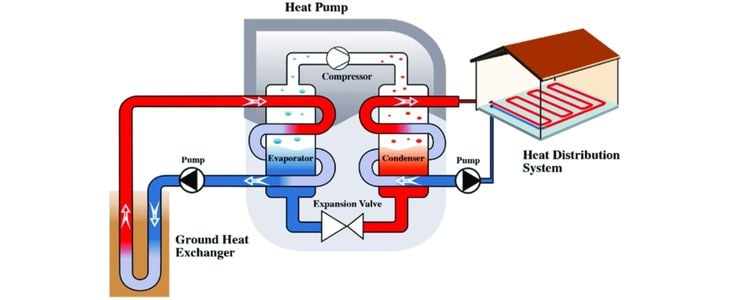Geothermal heating stands out today as one of the most sustainable heating alternatives. Derived from a constant, renewable source of underground temperatures and paired with advanced technologies such as geothermal heat pumps, entire cities and projects are adopting this option for its multiple economical and environmental benefits.
How does geothermal heating work and what are current options to access this technology in the most efficient way? From our experience in the latest heating technologies, at Araner we share the top keys to understand geothermal heating and the role of the ground source heat pump models.
What is geothermal heating
Geothermal heating is a heating model that employs the near-constant temperature maintained below the earth’s surface.
While above-ground temperatures in summer and winter vary in an uncontrolled manner, underground temperatures remain constant. These temperature values vary depending on the exact location, but they typically range from 45°F (7°C) to 75°F (21°C). These, in fact, increase approximately 1°F for every 70 feet in depth. Additionally, some regions (for instance, those with volcanic activity) have access to extreme heated temperatures at a location that is closer to the surface.
Geothermal heating is thus considered to derive from a renewable resource and helping developers to move away from fossil fuels and carbon emissions, among other key benefits that we explore below in the article.
Geothermal heating and large scale heat pumps: a path towards sustainability
Modern heating technologies have devised a number of ways to harness this thermal energy potential in the search for increasingly efficient and sustainable alternatives.
This is how the current geothermal heating options appeared: direct geothermal and ground source heat pump model.
The first option is available in a few places around the globe, where below-ground temperatures are warm enough and easily accessible. But it’s in fact the latter option (the use of geothermal heat pumps) that is facilitating the employment of geothermal heating across the globe in a highly efficient manner, even in territories where geothermal heat is not an immediate option.
Heat pump technologies rely on exchanging heat by pulling it from an external source (for instance, outside air temperature). In the case of geothermal heat pumps (GHPs), their efficiency derives from the use of the constant temperatures below the surface as an exchange temperature source.

As geothermal temperature values tend to be constant (warmer than the air during the winter and cooler than the air in summer), heat pumps are able to exchange heat with the earth more efficiently by employing a ground heat exchanger. As such, the geothermal model is, in fact, one of the best heating sources for district heating.
In other words, these heating technologies make the most of a naturally-occurring phenomenon and generate a renewable, environmentally-friendly heating process for space heating or cooling. Additionally, they can be employed for water heating as well.
The result is a highly efficient model that, when incorporated into systems such as district heating, is enabling smart city developments, among other applications.
The sustainability of geothermal heat pumps is further guaranteed by the use of renewable and clean electricity sources to power the heat exchange and operate the system. Paired up with heat pumps’ outstanding energy efficiency values (which we explore further below in this article), geothermal heating is finally accessible in a wide array of territories around the globe.
How geothermal heating and heat pumps work combined
The geothermal heat pump model consists of a system where a heat pump operates to deliver a heat-conveying liquid through an underground piping structure. Through this system, heat is transported to each individual destination, including residential buildings and other structures.

When designed for heating purposes, the ground source heat pump model works through the following steps:
- The heat pump circulates water or another heat-transporting fluid through an underground piping system
- The fluid absorbs (collects) heat from the underground soil, which is at a warmer temperature than ambient air
- This heat is used in the heat pump, in a mechanical vapor compression cycle to increase the temperature up to usable level.
- This heat is then transported to each individual location (for instance, a residential building or district heating system).
However, geothermal heat pumps can also be employed for cooling purposes. In this case, it follows a reverse process: it is able to remove heat from inside a building into the underground system through the following steps:
- The fluid absorbs heat from the air inside each building location using a heat exchanger
- The liquid moves through the pipe system, discharging heat into the soil as it passes through the loop
- Now at a lower temperature, the liquid can return to each individual location or building to continue absorbing heat in a recirculation process
- Again, the movement is facilitated by the use of geothermal heat pumps exerting a mechanic compression cycle able to generate cooling.

The benefits of geothermal heat pumps
According to the International Ground Source Heat Pump Association, the choice of ground source heat pump systems provides savings in energy consumption of between 25 to 50%; additionally, heating efficiencies of between 50 to 70% can be achieved as compared to other heating technologies.
In fact, this is paired with the extraordinary efficiency provided by industrial heat pumps. Measured by the coefficient of performance, well-adjusted heat pumps provide COP values of between 3 to 6 units: for every unit of electrical energy consumed, they’re able to generate between 3 to 6 units of heating energy.
Other benefits of geothermal heating using heat pumps include outstanding heat decarbonisation levels of between 55 to 62%. This translates into this system becoming one of the most viable options for achieving sustainability and carbon neutrality.
Araner: your partner to accessing geothermal heating benefits
As we’ve seen, pairing geothermal heating with geothermal heat pumps results in an extremely efficient and sustainable solution for both heating and cooling needs that is driving the switch towards new and greener heating paradigms around the globe.
At Araner, we’re at the forefront of heating technologies, helping develop increasingly efficient models that are facilitating sustainable and modern urban heating systems such as district heating systems.
As such, one of our key developments today is helping companies and developers harness the power of geothermal heating. Through our end-to-end processes, we provide consulting, designing, manufacturing and implementation services.
Want to learn more about geothermal heating and the geothermal heat pumps model? At Araner we can help you. Download our free heat pumps technical ebook or get in touch with us to discover this model’s potential and how it may relate to your project’s needs.










